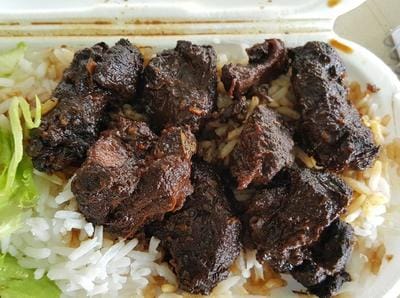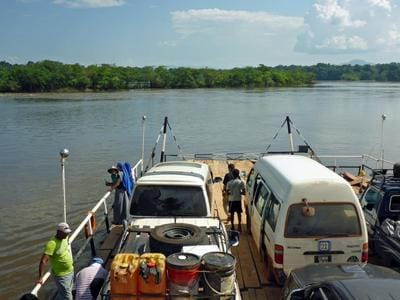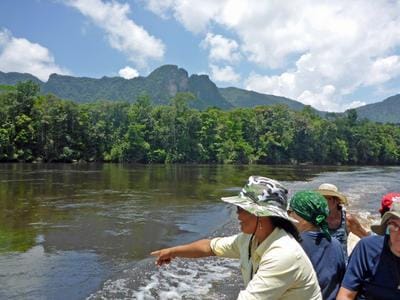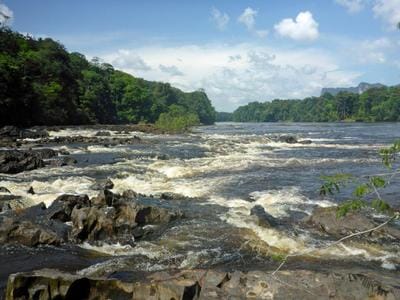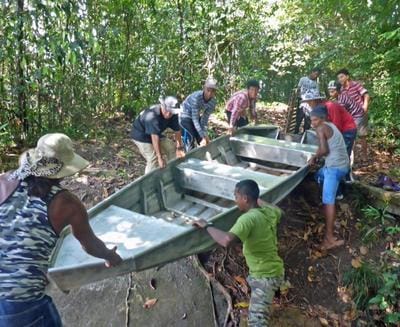Kaieteur - the world's Tallest waterfall

By Edward Placidi. Edward is a freelance travel writer/photographer who has lived and traveled in 90 countries, including extended overland journeys across Africa, Europe, South America and Asia. He has penned articles for dozens of newspapers, magazines and websites. When not travelling he is whipping up delicious dishes inspired by his Tuscan grandmother who taught him to cook. A passionate Italophile and supporter of the Azzurri (Italian national soccer team), he lives in Los Angeles with his wife Marian.
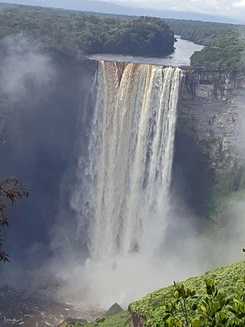
Nearing the summit, pulse racing and thighs burning from the steepness of the slope, a promising din announced the proximity of Kaieteur. Once atop the summit, negotiating a forest of giant bromeliads, the roar of the waters grew louder with each step, and the vibration of the ground under my feet was palpable. Walking out on a precipitous ledge, the first glimpse of the falls took my breath away.
The bottom was suddenly dropping out of the wide, muddy Potaro River. Its entire massive flow – that can reach 136,000 gallons per second during the May/June rainy season – was nose-diving straight down to the pool below that is completely obscured by the vast quantity and breadth of the mist. As we continued on to other ledges, we moved closer and closer to the cascade – reaching a point where we were only a few feet from the drop-off-point of thundering Kaieteur, experiencing an intimacy with the natural wonder not possible at such famous spots as Niagara and Iguassu.
The waters plunge 741 feet, making Kaieteur the planet’s highest single-drop waterfall. It is the top attraction of Guyana, a small and little-known South American country that lures only a trickle of tourists. The majority come specifically to see Kaieteur, most on a half-day air tour from Georgetown, the capital. But to truly immerse yourself in and absorb the grandeur of the spectacular cataract, you have to hit the road on an overland journey.
The route is long and circuitous, employing various modes of transportation with the final, and punishing, leg on foot. I met my guide, Roy, for the first time in the early morning at Georgetown’s bus depot. The former Kaieteur National Park warden assured me that “I will be with you the entire time…and we are to going to see the best of Guyana over these five days.” And off we went by minibus on an eight-hour, gut-wrenching drive on a cratered red-dirt track through dense rainforest.
Along the way we stopped at police checkpoints where travelers heading into the interior are registered, had lunch at a roadside dive of the spicy national dish of Pepperpot with “Wild Cow” (tapir meat, that was delicious), and took a ferry across the country’s largest river, the Essequibo. Late afternoon we arrived in Mahdia, a scruffy settlement and supply depot that supports the miners searching for gold and diamonds in the area – who have become controversial in Guyana because of the ecological damage due to their activities.
The bottom was suddenly dropping out of the wide, muddy Potaro River. Its entire massive flow – that can reach 136,000 gallons per second during the May/June rainy season – was nose-diving straight down to the pool below that is completely obscured by the vast quantity and breadth of the mist. As we continued on to other ledges, we moved closer and closer to the cascade – reaching a point where we were only a few feet from the drop-off-point of thundering Kaieteur, experiencing an intimacy with the natural wonder not possible at such famous spots as Niagara and Iguassu.
The waters plunge 741 feet, making Kaieteur the planet’s highest single-drop waterfall. It is the top attraction of Guyana, a small and little-known South American country that lures only a trickle of tourists. The majority come specifically to see Kaieteur, most on a half-day air tour from Georgetown, the capital. But to truly immerse yourself in and absorb the grandeur of the spectacular cataract, you have to hit the road on an overland journey.
The route is long and circuitous, employing various modes of transportation with the final, and punishing, leg on foot. I met my guide, Roy, for the first time in the early morning at Georgetown’s bus depot. The former Kaieteur National Park warden assured me that “I will be with you the entire time…and we are to going to see the best of Guyana over these five days.” And off we went by minibus on an eight-hour, gut-wrenching drive on a cratered red-dirt track through dense rainforest.
Along the way we stopped at police checkpoints where travelers heading into the interior are registered, had lunch at a roadside dive of the spicy national dish of Pepperpot with “Wild Cow” (tapir meat, that was delicious), and took a ferry across the country’s largest river, the Essequibo. Late afternoon we arrived in Mahdia, a scruffy settlement and supply depot that supports the miners searching for gold and diamonds in the area – who have become controversial in Guyana because of the ecological damage due to their activities.
Within minutes we were rolling out of Mahdia in a vintage Toyota Land Cruiser descending a precipitous and muddy trail, fording huge puddles filled with rainwater colored a neon orange by the minerals in the soil. Less than an hour of often-violent twisting and shaking down the steep grade, a river bank and a few brightly painted clapboard shacks came into view. And then we heard the music, the volume of the Jamaican Reggae increasing with every turn of the Toyota’s wheels. By the time we reached the river, the decibel level shook the ground.
Since this is miner country, Roy explained that river-side outposts with generators have been established in the forest to supply miners with provisions and cold beer – and they are run by Rastafarians, hence the music as well as the wafting smell of ganja.
With the fading sun turning the forest ebony, we embarked on a small outboard-powered panga, heading up the Potaro. We navigated by a faint line of light cast by a sliver of a moon, the only sound the hum of the motor. It was just a lull before the next musical storm: Arriving at another crude miners’ outpost, Roy cooked a noodle dinner over a camp stove to blasting Reggae sounds, while a blotto miner chatted us up and ordered us rounds of beer. “Man can’t stand on only one leg,” Roy laughed. Translation: you are never allowed to have just one drink in Guyana. Apparently, I had not left civilization behind after all – but after sleeping in a stuffy, primitive wood cabin, everything would change the next day.
Cruising upriver on a warm and sunny morning, an important boundary was crossed: we entered Kaieteur National Park where mining is forbidden and the rainforest protected. Along the way, we carried the panga around the Wartuk Rapids to continue our journey, swan in the Potaro’s cool orange waters, and sailed past daunting rock escarpments shooting up from the rainforest floor.
Since this is miner country, Roy explained that river-side outposts with generators have been established in the forest to supply miners with provisions and cold beer – and they are run by Rastafarians, hence the music as well as the wafting smell of ganja.
With the fading sun turning the forest ebony, we embarked on a small outboard-powered panga, heading up the Potaro. We navigated by a faint line of light cast by a sliver of a moon, the only sound the hum of the motor. It was just a lull before the next musical storm: Arriving at another crude miners’ outpost, Roy cooked a noodle dinner over a camp stove to blasting Reggae sounds, while a blotto miner chatted us up and ordered us rounds of beer. “Man can’t stand on only one leg,” Roy laughed. Translation: you are never allowed to have just one drink in Guyana. Apparently, I had not left civilization behind after all – but after sleeping in a stuffy, primitive wood cabin, everything would change the next day.
Cruising upriver on a warm and sunny morning, an important boundary was crossed: we entered Kaieteur National Park where mining is forbidden and the rainforest protected. Along the way, we carried the panga around the Wartuk Rapids to continue our journey, swan in the Potaro’s cool orange waters, and sailed past daunting rock escarpments shooting up from the rainforest floor.
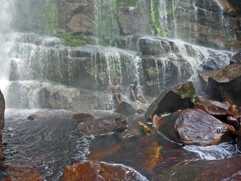
Suddenly, impassable rapids ended river travel; we would hoof it for the remainder of the trip. Howler monkeys fled as we walked into the clearing around Tukeit, one of two simple guest houses in the national park with a few beds and hooks to string hammocks. A quiet, peaceful spot but with danger underfoot: Roy offered us ‘snake sticks’ to protect against the deadly fer de lance.
As a warmup to Kaieteur, we trekked a serpentine path under a thick canopy, negotiating a maze of vines and hardwood trees, to another spectacular waterfall – accompanied by fluttering, iridescent Blue Morphos, South America’s largest butterflies. The powerful flow over Stonecreek Falls plummets some 100 feet, ricocheting off rocks, and we stood under the cascade to enjoy a deep head and shoulder massage.
As a warmup to Kaieteur, we trekked a serpentine path under a thick canopy, negotiating a maze of vines and hardwood trees, to another spectacular waterfall – accompanied by fluttering, iridescent Blue Morphos, South America’s largest butterflies. The powerful flow over Stonecreek Falls plummets some 100 feet, ricocheting off rocks, and we stood under the cascade to enjoy a deep head and shoulder massage.
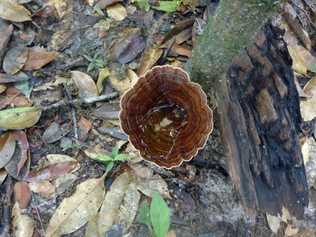
For the final leg to Kaieteur, we had to overcome the “Oh My God” challenge: The climb to the top of the falls is so steep and gains altitude so fast that it sucks the air from your lungs and robs the energy from your legs. We were making good time though, until the heavens parted. The rain was so intense that the path became a small stream and each step heavier that the previous one. Arriving at the summit, the downpour abruptly stopped – as did my heart at the first sighting of the falls. Coloring the explosive rush of plunging water and thundering roar was a rainbow streaking across the facade of the falls.
We slept in hammocks in the run down, nearly half-century-old guest house, but change is coming – maybe. “The government has been promising for years to build a better and larger guest house, allowing visitors to stay overnight or longer,” said Roy. “It would bring increased tourism opportunities for tour operators, airlines and guides.” For now, however, there is just a humble, threadbare facility that blissfully keeps Kaieteur in a tourism time warp.
Guyana boasts exceptional biodiversity and some of its highlights can be experienced at Kaieteur – from hiking a forest of hardwood trees and giant fungus, searching for the tiny, iridescent-yellow Golden Frog and birdwatching for Toucans and the brilliant-orange Cock of the Rock, to drinking from water-carrying vines and seeing carnivorous plants in action.
We slept in hammocks in the run down, nearly half-century-old guest house, but change is coming – maybe. “The government has been promising for years to build a better and larger guest house, allowing visitors to stay overnight or longer,” said Roy. “It would bring increased tourism opportunities for tour operators, airlines and guides.” For now, however, there is just a humble, threadbare facility that blissfully keeps Kaieteur in a tourism time warp.
Guyana boasts exceptional biodiversity and some of its highlights can be experienced at Kaieteur – from hiking a forest of hardwood trees and giant fungus, searching for the tiny, iridescent-yellow Golden Frog and birdwatching for Toucans and the brilliant-orange Cock of the Rock, to drinking from water-carrying vines and seeing carnivorous plants in action.
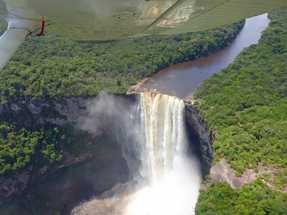
At dusk, sitting on rocks at the top of the falls only a few feet from the perilous edge, we watched as hundreds of swifts gathered in the sky. The sleek black birds swooped in unison, like the tail of a streaking comet, then suddenly dove at breakneck speed to their roosts behind the falls. We watched the spectacle – one of nature’s great shows – duplicate itself half a dozen times until the entire flock had returned to Kaieteur for the night.
The overland tours to Kaieteur don’t follow the same route back, but instead fly out. The vista from the sky is stupendous, and revealing, illustrating the gargantuan dimension of the falls and the context of endless rainforest and rock escarpments. The falls soon faded from view, but I will never forget their sublime majesty.
The overland tours to Kaieteur don’t follow the same route back, but instead fly out. The vista from the sky is stupendous, and revealing, illustrating the gargantuan dimension of the falls and the context of endless rainforest and rock escarpments. The falls soon faded from view, but I will never forget their sublime majesty.
Fact Box
WikiTravel: http://wikitravel.org/en/Guyana
Lodging in Georgetown: Rainforest B&B http://www.rainforestbbguy.com/index.html
WikiTravel: http://wikitravel.org/en/Guyana
Lodging in Georgetown: Rainforest B&B http://www.rainforestbbguy.com/index.html
|
Images copyright of the Author
Click on any image to enlarge it |
